
A pencil is a writing or drawing implement with a solid pigment core in a protective casing that reduces the risk of core breakage, and keeps it from marking the user's hand.

Surrealist automatism is a method of art-making in which the artist suppresses conscious control over the making process, allowing the unconscious mind to have great sway. Early 20th-century Dadaists, such as Hans Arp, made some use of this method through chance operations. Surrealist artists, most notably André Masson, adapted to art the automatic writing method of André Breton and Philippe Soupault who composed with it Les Champs Magnétiques in 1919. The Automatic Message (1933) was one of Breton's significant theoretical works about automatism.
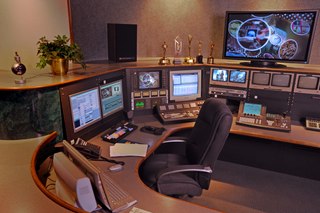
Non-linear editing is a form of offline editing for audio, video, and image editing. In offline editing, the original content is not modified in the course of editing. In non-linear editing, edits are specified and modified by specialized software. A pointer-based playlist, effectively an edit decision list (EDL), for video and audio, or a directed acyclic graph for still images, is used to keep track of edits. Each time the edited audio, video, or image is rendered, played back, or accessed, it is reconstructed from the original source and the specified editing steps. Although this process is more computationally intensive than directly modifying the original content, changing the edits themselves can be almost instantaneous, and it prevents further generation loss as the audio, video, or image is edited.
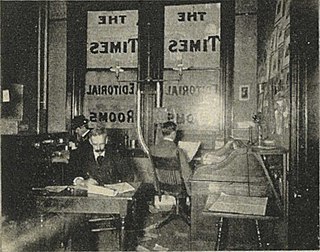
Editing is the process of selecting and preparing written, photographic, visual, audible, or cinematic material used by a person or an entity to convey a message or information. The editing process can involve correction, condensation, organisation, and many other modifications performed with an intention of producing a correct, consistent, accurate and complete piece of work.

An engineering drawing is a type of technical drawing that is used to convey information about an object. A common use is to specify the geometry necessary for the construction of a component and is called a detail drawing. Usually, a number of drawings are necessary to completely specify even a simple component. The drawings are linked together by a master drawing or assembly drawing which gives the drawing numbers of the subsequent detailed components, quantities required, construction materials and possibly 3D images that can be used to locate individual items. Although mostly consisting of pictographic representations, abbreviations and symbols are used for brevity and additional textual explanations may also be provided to convey the necessary information.

Video editing is the manipulation and arrangement of video shots. Video editing is used to structure and present all video information, including films and television shows, video advertisements and video essays. Video editing has been dramatically democratized in recent years by editing software available for personal computers. Editing video can be difficult and tedious, so several technologies have been produced to aid people in this task. Pen based video editing software was developed in order to give people a more intuitive and fast way to edit video.
Proofreading is the reading of a galley proof or an electronic copy of a publication to find and correct reproduction errors of text or art. Proofreading is the final step in the editorial cycle before publication.
Copy editing is the process of revising written material (copy) to improve readability and fitness, as well as ensuring that text is free of grammatical and factual errors. The Chicago Manual of Style states that manuscript editing encompasses "simple mechanical corrections through sentence-level interventions to substantial remedial work on literary style and clarity, disorganized passages, baggy prose, muddled tables and figures, and the like ". In the context of print publication, copy editing is done before typesetting and again before proofreading. Outside traditional book and journal publishing, the term copy editing is used more broadly, and is sometimes referred to as proofreading, or the term copy editing sometimes includes additional tasks.
Optical mark recognition is the process of reading information that people mark on surveys, tests and other paper documents.

A penciller is an artist who works on the creation of comic books, graphic novels, and similar visual art forms, with a focus on the initial pencil illustrations, usually in collaboration with other artists, who provide inks, colors and lettering in the book, under the supervision of an editor.
In filmmaking, dailies are the raw, unedited footage shot during the making of a motion picture. The term comes from when movies were all shot on film because usually at the end of each day, the footage was developed, synced to sound, and printed on film in a batch for viewing the next day by the director, selected actors, and film crew members. After the advent of digital filmmaking, "dailies" were available instantly after the take and the review process was no longer tied to the overnight processing of film and became more asynchronous. Now some reviewing may be done at the shoot, even on location, and raw footage may be immediately sent electronically to anyone in the world who needs to review the takes. For example, a director can review takes from a second unit while the crew is still on location or producers can get timely updates while travelling. Dailies serve as an indication of how the filming and the actors' performances are progressing. The term was also used to describe film dailies as "the first positive prints made by the laboratory from the negative photographed on the previous day".

In graphic design, page layout is the arrangement of visual elements on a page. It generally involves organizational principles of composition to achieve specific communication objectives.
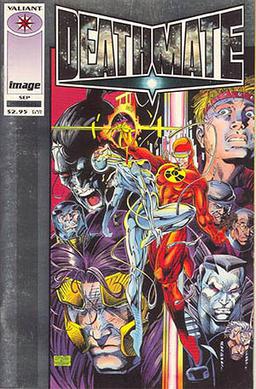
Deathmate was a six-part comic book crossover between Valiant Comics and Image Comics published in 1993 and 1994.
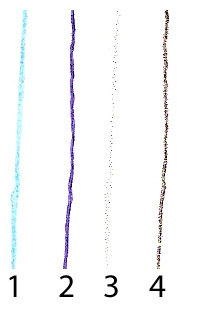
Non-photo blue is a common tool in the graphic design and print industry, being a particular shade of blue that cannot be detected by graphic arts camera film. This allows layout editors to write notes to the printer on the print flat which will not show in the final form. It also allows artists to lay down sketch lines without the need to erase after inking.

A photo book or photobook is a book in which photographs make a significant contribution to the overall content. A photo book is related to and also often used as a coffee table book.
Blue pencil may refer to:

RawTherapee is application software for processing photographs in raw image formats, as created by many digital cameras. It comprises a subset of image editing operations specifically aimed at non-destructive post-production of raw photos and is primarily focused on improving a photographer's workflow by facilitating the handling of large numbers of images. It is notable for the advanced control it gives the user over the demosaicing and developing process. It is cross-platform, with versions for Microsoft Windows, macOS and Linux.
The blue pencil doctrine is a legal concept in common law countries, where a court finds that portions of a contract are void or unenforceable, but other portions of the contract are enforceable. The Blue Pencil Rule allows the legally valid, enforceable provisions of the contract to stand despite the nullification of the legally void, unenforceable provisions. However, the revised version must represent the original meaning; the rule may not be invoked, for example, to delete the word "not" and thereby change a negative to a positive.
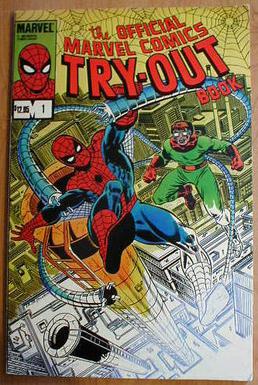
The Official Marvel Comics Try-Out Book is an oversize book originally published by Marvel Comics in 1983. Conceived by then-Editor-in-Chief Jim Shooter, the book was in the form of a contest encouraging up-and-coming comics creators to try their hand at getting a job with the company. The winner would be awarded a professional assignment with Marvel.
The Blue and Brown Books are two sets of notes taken during lectures conducted by Ludwig Wittgenstein from 1933 to 1935. They were mimeographed as two separate books, and a few copies were circulated in a restricted circle during Wittgenstein's lifetime. The lecture notes from 1933–1934 were bound in blue cloth, and the notes dictated in 1934–1935 were bound in brown. Rush Rhees published these together for the first time in 1958 as Preliminary Studies for the "Philosophical Investigations".












